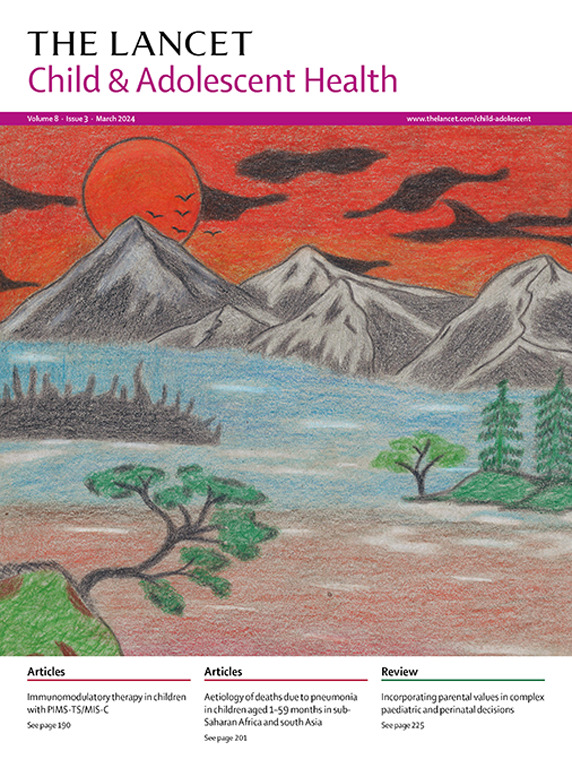Predicting paediatric pneumonia severity in the emergency department: a multinational prospective cohort study of the Pediatric Emergency Research Network
IF 15.5
1区 医学
Q1 PEDIATRICS
引用次数: 0
Abstract
Background
Risk stratification tools for paediatric community-acquired pneumonia (CAP) in well-resourced settings are scarce. We prospectively developed models to predict CAP severity within a multinational cohort of paediatric emergency departments (EDs). Our primary objective was to develop a risk prediction model to discriminate between mild CAP and moderate or severe CAP to assist clinicians in determining the need for hospitalisation.
Methods
This prospective cohort study was conducted from Feb 6, 2019, to June 30, 2021, at 73 EDs in 14 countries. Children aged 3 months to <14 years with clinical diagnoses of CAP were included. Children were excluded if they were recently hospitalised or had a chronic complex condition (eg, immunodeficiency). The primary outcome was severity, defined as mild (CAP treated in the outpatient setting or hospitalisation <24 h with no use of oxygen or intravenous fluids during that time), moderate (hospitalisation <24 h with oxygen or fluids, or hospitalisation ≥24 h regardless of interventions but without an outcome qualifying as severe CAP), or severe (chest drainage, intensive care unit admission >24 h, positive-pressure ventilation, septic shock, vasoactive infusions, extracorporeal membrane oxygenation, or death) occurring within 7 days of the ED visit. Models were developed using logistic regression with bootstrap validation.
Findings
Of 2222 children in the overall study population (1103 [49·7%] female, 1119 [50·3%] male; median age 3 years [IQR 1–5]), 1290 (58·1%) had mild CAP, 812 (36·5%) moderate, and 120 (5·4%) severe. Primary analyses were performed in 1901 patients with complete data: 1011 (53·2%) mild, 772 (40·6%) moderate, and 118 (6·2%) severe CAP. Congestion or rhinorrhoea was negatively associated with moderate or severe CAP (adjusted odds ratio 0·59 [95% CI 0·46–0·76]), while abdominal pain (1·52 [1·17–1·97]), refusal to drink (1·57 [1·24–2·00]), antibiotics before ED visit (1·64 [1·29–2·10]), chest retractions (2·86 [2·24–3·65]), respiratory rate above the 95th percentile for age (1·63 [1·29–2·06]), heart rate above the 95th percentile for age (1·64 [1·27–2·12]), and hypoxaemia (oxygen saturation 90–92%, 3·24 [2·46–4·27]; <90%, 13·39 [8·64–20·73]) were positively associated. The model accurately discriminated between mild CAP and moderate or severe CAP (c-statistic 0·82 [95% CI 0·80–0·84]). Similar results were found in those with radiographic CAP, with decreased breath sounds and multifocal opacities on radiography as additional predictors (c-statistic 0·82 [0·80–0·85]).
Interpretation
We developed accurate, pragmatic severity risk prediction models among children with CAP. After future external validation, these models have the potential to provide individualised risk assessments that can be incorporated into clinical judgement in well-resourced health systems to improve management.
Funding
Division of Emergency Medicine at Cincinnati Children's Hospital Medical Center, Division of Emergency Medicine at Ann & Robert H. Lurie Children's Hospital of Chicago, and Department of Emergency Medicine at University of California, Davis.
在急诊科预测儿童肺炎严重程度:儿科急诊研究网络的一项多国前瞻性队列研究
背景:在资源充足的环境中,用于儿科社区获得性肺炎(CAP)的风险分层工具很少。我们前瞻性地开发模型来预测多国儿科急诊科(ed)的CAP严重程度。我们的主要目的是建立一个风险预测模型来区分轻度CAP和中度或重度CAP,以帮助临床医生确定是否需要住院治疗。该前瞻性队列研究于2019年2月6日至2021年6月30日在14个国家的73名ed中进行。纳入临床诊断为CAP的3个月至14岁儿童。如果儿童最近住院或患有慢性复杂疾病(如免疫缺陷),则排除在外。主要结局是严重程度,定义为轻度(CAP在门诊治疗或住院24小时,在此期间不使用氧气或静脉输液),中度(住院24小时,使用氧气或液体,或住院≥24小时,无论采取何种干预措施,但没有符合严重CAP的结局),或重度(胸腔引流,重症监护病房入院24小时,正压通气,感染性休克,血管活性输注。体外膜氧合,或死亡)在急诊科就诊后7天内发生。模型采用逻辑回归与自举验证。总研究人群中2222例儿童(女性1103例[49.7%],男性1119例[50.3%];中位年龄3岁[IQR 1-5]), 1290例(58.1%)为轻度CAP, 812例(36.5%)为中度CAP, 120例(5.4%)为重度CAP。对1901例资料完整的患者进行了初步分析:轻度CAP 1011例(53.2%),中度CAP 772例(40.6%),重度CAP 118例(6.2%)。充血或流涕与中度或重度CAP呈负相关(校正比值比0.59 [95% CI 0.46 - 0.76]),腹痛(1.52[1.17 - 1.97])、拒绝饮酒(1.57[1.24 - 2.00])、急诊科就诊前使用抗生素(1.64[1.29 - 2.10])、胸后缩回(2.86[2.24 - 3.65])、呼吸频率高于年龄第95百分位数(1.63[1.29 - 2.06])、心率高于年龄第95百分位数(1.64[1.27 - 2.12])、低氧血症(血氧饱和度90 ~ 92%,3.24 [2.46 ~ 4.27];<90%, 13.39[8.64 - 20.73])呈正相关。该模型准确区分轻度CAP和中度或重度CAP (c-统计量0.82 [95% CI 0.80 - 0.84])。同样的结果也出现在放射学CAP患者中,呼吸音减少和放射学多灶性混浊是额外的预测因素(c统计量为0.82[0.80 - 0.85])。我们在CAP患儿中开发了准确、实用的严重程度风险预测模型。在未来的外部验证后,这些模型有可能提供个性化的风险评估,可纳入资源充足的卫生系统的临床判断,以改善管理。辛辛那提儿童医院医学中心急诊医学部,安医院急诊医学部;芝加哥罗伯特·h·卢里儿童医院,以及加州大学戴维斯分校急诊科。
本文章由计算机程序翻译,如有差异,请以英文原文为准。
求助全文
约1分钟内获得全文
求助全文
来源期刊

Lancet Child & Adolescent Health
Psychology-Developmental and Educational Psychology
CiteScore
40.90
自引率
0.80%
发文量
381
期刊介绍:
The Lancet Child & Adolescent Health, an independent journal with a global perspective and strong clinical focus, presents influential original research, authoritative reviews, and insightful opinion pieces to promote the health of children from fetal development through young adulthood.
This journal invite submissions that will directly impact clinical practice or child health across the disciplines of general paediatrics, adolescent medicine, or child development, and across all paediatric subspecialties including (but not limited to) allergy and immunology, cardiology, critical care, endocrinology, fetal and neonatal medicine, gastroenterology, haematology, hepatology and nutrition, infectious diseases, neurology, oncology, psychiatry, respiratory medicine, and surgery.
Content includes articles, reviews, viewpoints, clinical pictures, comments, and correspondence, along with series and commissions aimed at driving positive change in clinical practice and health policy in child and adolescent health.
 求助内容:
求助内容: 应助结果提醒方式:
应助结果提醒方式:


